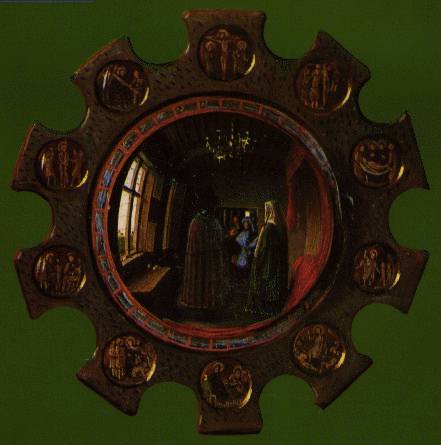벨기에와 네덜란드 지역을 플랑드르라 불렀다.
북유럽에서는 얀 반 에이크가 거울을 이용하여 사실성을 부각시키고 세세한 부분을 그리기 위해 유화를 발명하였다. <아르놀피니의 약혼>은 사진과 같은 가장 유명한 초상화이다.
Eyck, Jan van (b. before 1395, Maaseik, Bishopric of Li?e, Holy Roman Empire [now in Belgium]--d. before July 9, 1441, Bruges), Flemish painter who perfected the newly developed technique of oil painting. His naturalistic panel paintings, mostly portraits and religious subjects, made extensive use of disguised religious symbols. His masterpiece is the altarpiece in the cathedral at Ghent, the Adoration of the Lamb (1432). Hubert van Eyck is thought by some to have been Jan's brother.
Jan van Eyck, the most famous and innovative Flemish painter of the 15th century, is thought to have come from the village of Maaseyck in Limbourg.
No record of his birthdate survives, but it is believed to have been about 1390; his career, however, is well documented. He was employed (1422-24) at the court of John of Bavaria, count of Holland, at The Hague, and in 1425 he was made court painter and valet de chambre to Duke Philip the Good of Burgundy. He became a close member of the duke's court and undertook several secret missions for him, including a trip (1428-29) to Spain and Portugal in connection with negotiations that resulted in the marriage (1430) of Philip of Burgundy and Isabella of Portugal. Documents show that in 1432-33 van Eyck bought a house in Bruges. He signed and dated a number of paintings between 1432 and 1439, all of which are painted in oil and varnished. According to documents, he was buried on July 9, 1441.
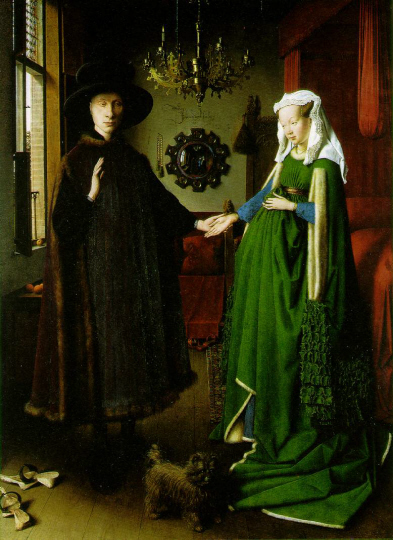
The Marriage of Giovanni Arnolfini and Giovanna Cenami; 1434 (130 Kb); Oil on wood, 81.8 x 59.7 cm (32 1/4 x 23 1/2 in); National Gallery, London
아르놀피니 부부의 초상 - 결혼 증명서?
This title has traditionally been given to this painting because it was thought to be a form of ``wedding certificate'' for Giovanni Arnolfini and Giovanna Cenami, who married in Bruges in 1434. He was an Italian merchant, she the daughter of an Italian merchant. Their grave, youthful faces both have a lovely responsability that is typical of van Eyck.
Van Eyck's art reached perhaps its greatest triumph in the painting of portraits. One of his most famous portraits is The betrothal of the Arnolfini, which represents an Italian merchant, Giovanni Arnolfini, who had come to the Netherlands on business, with his bride Jeanne de Chenany. In its own way it was as new and as revolutionary as Donatello's or Masaccio's work in Italy. A simple corner of the real world had suddenly been fixed on to a panel as if by magic. Here it all was - the carpet and the slippers, the rosary on the wall, the little brush beside the bed, and the fruit on the window-sill. It is as if we could pay a visit to the Arnolfini in their house. The picture probably represents a solemn moment in their lives - their betrothal. The young woman has just put her right hand into Arnolfini's left and he is about to put his own right hand into hers as a solemn token of their union. Probably the painter was asked to record this important moment as a witness, just as a notary might be asked to declare that he has been present at a similar solemn act. This would explain why the master has put his name in a prominent position on the picture with the Latin words 'Johannes de eyck fuit hic' (Jan van Eyck was here). In the mirror at the back of the room we see the whole scene reflected from behind, and there, so it seems, we also see the image of the painter and witness. We do not know whether it was the Italian merchant or the northern artist who conceived the idea of making this use of the new kind of painting, which may be compared to the legal use of a photograph, properly endorsed by a witness. But whoever it was that originated this idea, he had certainly been quick to understand the tremendous possibilities which lay in Van Eyck's new way of painting. For the first time in history the artist became the perfect eye-witness in the truest sense of the term.
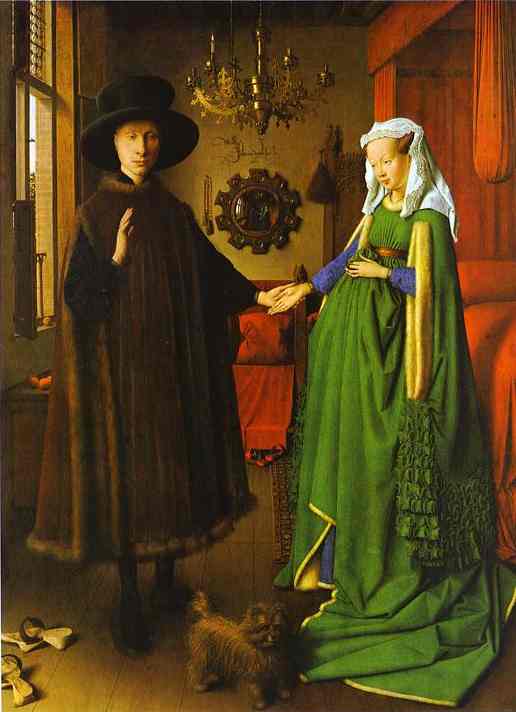
Symbolic candle
The solitary flame burning in bright daylight can be interpreted as the bridall candle, or God's all-seeing eye, or simply as a devotional candle. Another symbol is St Margaret (the patron saint of women in childbirth), whose image is carved on the high chairback.
샹들리에의 촛불은 만물을 꿰뚫어보는 그리스도를, 강아지는 부부사이의 정절, 벗어놓은 신발은 성스러운 서약의 장소이기 때문.
An elaborate signature
As today, marriages in 15th-century Flanders could take place privately rather than in church. Van Eyck's Latin signature, in the Gothic calligraphy used for legal documents, reads: ``Jan van Eyck was present'', and has been interpreted by some as an indication that the artist himself served as a witness.
The mirror is painted with almost miraculous skill. Its carved frame is inset with ten miniature medallions depicting scenes from the life of Christ. Yet more remarkable is the mirror's reflection, which includes van Eyck's own tiny self-portrait, accompanied by another man who may have been the official witness to the ceremony.
1434; detail: the ornate mirror on the back wall
Symbol of faithfulness
Almost every detail can be interpreted as a symbol. The companion dog is seen as a symbol of faithfulness and love. The fruits on the window ledge probably stand for fertility and our fall from Paradise. Even the discarded shoes are not thought to be incidental, but to signify the sanctity of marriage.

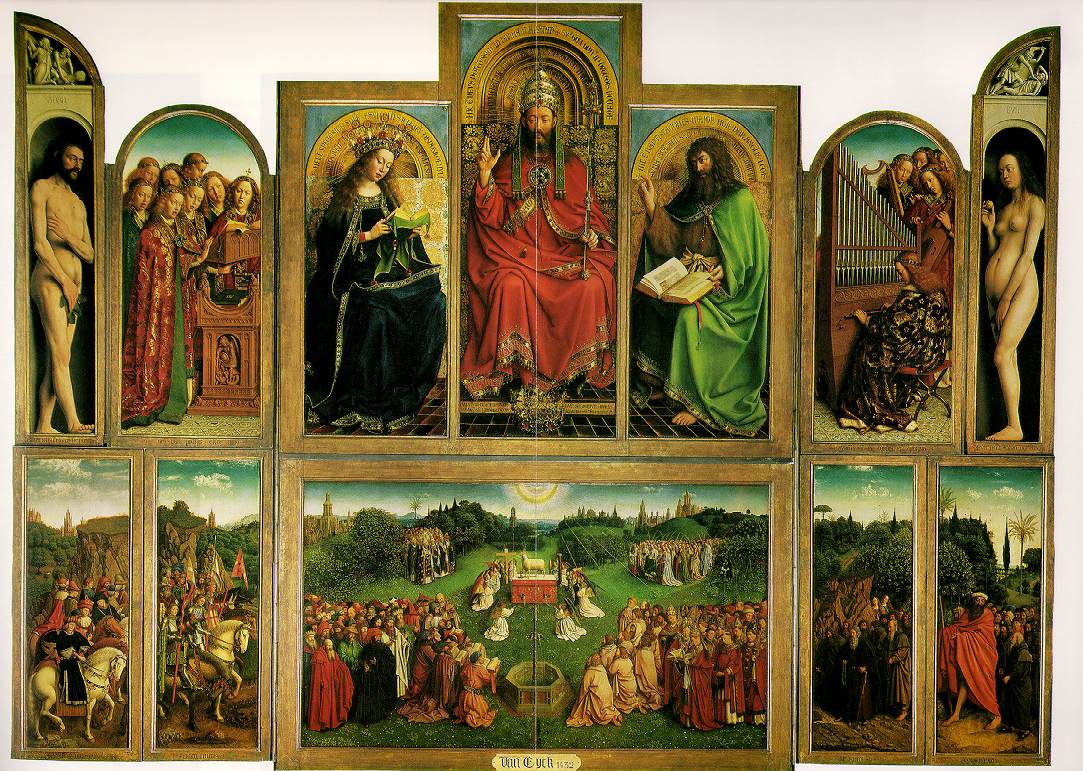
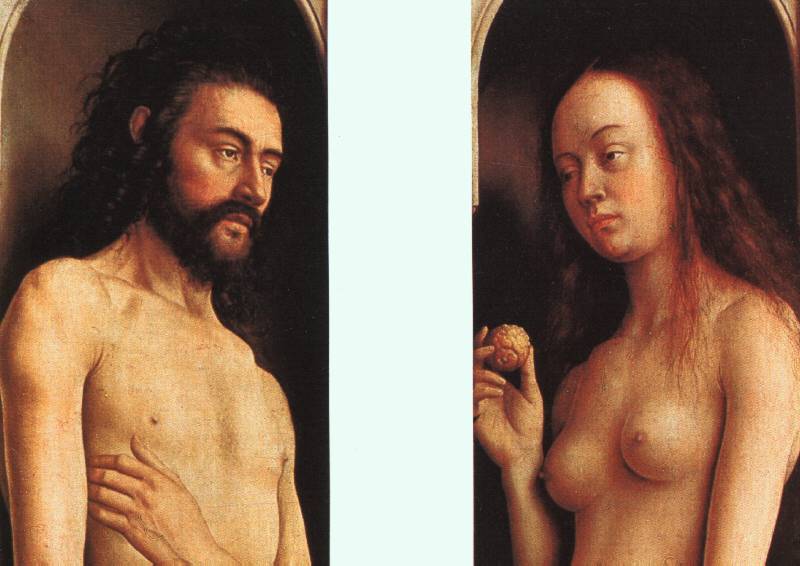
detail, Adam from left wing, Eve from right; 1432 (50 Kb); Panel painting; Cathedral of St. Bavo, Ghent
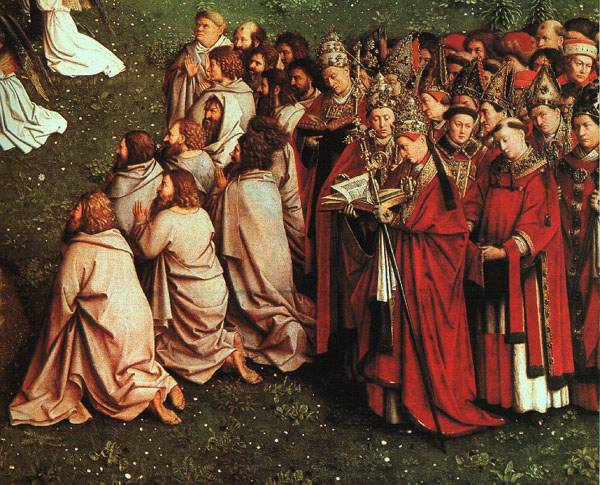
detail of lower central panel; 1432 (70 Kb); Panel painting; Cathedral of Bavon, Ghent
'History of Arts > Renaissance' 카테고리의 다른 글
| Titian (0) | 2020.05.18 |
|---|---|
| 북유럽르네상스-Dürer, Albrecht (1) | 2020.05.18 |
| 르네상스전성기: Leonardo DA VINCI (0) | 2020.05.11 |
| 르네상스전성기: Michelangelo di Lodovico Buonarroti Simoni (2) | 2020.05.11 |
| 모나리자 르네상스 전성기 (0) | 2020.05.11 |
